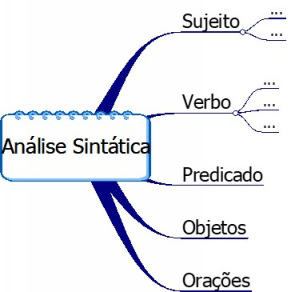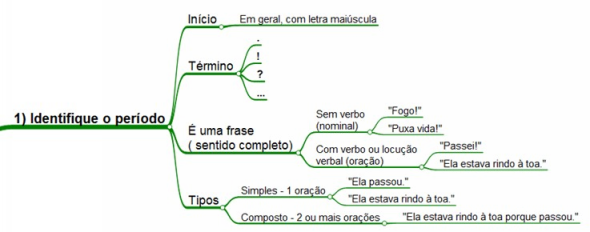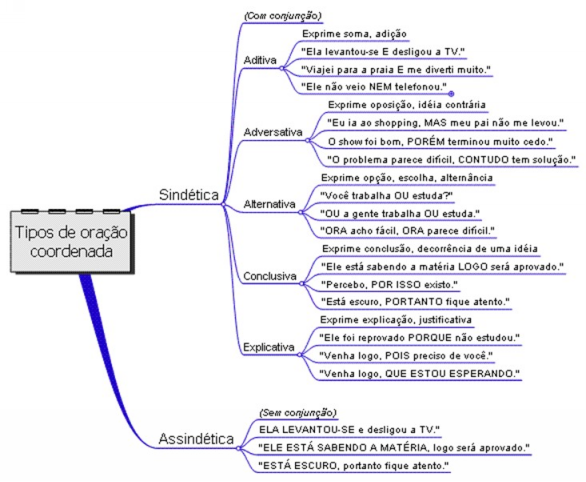Learning syntactic analysis in a fast and easy way
A well-structured mind map for accelerated learning
Two days before a syntactic analysis test, my son said he knew nothing of the subject. Would it be possible to do something in time? Well - it was!
A certain Saturday...
On what was until then a peaceful Saturday afternoon, my son, then a preteen in middle school, turned to me and said:

My initial reaction was a feeling that it wouldn’t be possible. But after questioning and reflecting that conclusions can be superficial, premature, or hasty, I decided to try something anyway, even if only to clear my conscience. Incidentally, if it were today, it would be easier; my thinking could be described as, “it doesn’t seem possible with the information and options I have at the moment.”
Searching then for what to do, the idea of making a mind map emerged.

I already had good experience in making mind maps of discursive texts. I also had an app, which would make editing and printing easier; In my opinion, paper was the best option for him to use the mind map.
Version 1
I took the textbook (Portuguese) and went through the chapters, selecting the relevant content and putting it on the mind map, following the structure of the book: subject, predicate, verb, direct and indirect objects, classification of sentences and so on, with detailed subtopics. This first version was similar to the one below (the original has not been preserved):

I showed him the mind map while it was still on the computer, to check if at least I was headed in the right direction. He didn't even have to speak; his expression revealed to me that there had been no progress.

What could be missing?
Version 2
I then had the insight that, as I said, thereafter marked my teaching career: the probable cause for him not being able to use that content could be simply that he didn’t know what to do.

I went back to the mind map and prepared a second version. I changed the organization of the topics to put together a script, a step-by-step guide that could be followed. I looked for a logical sequence in that content and found steps like:
- Identify the sentence.
- Look for the clauses.
- Analyze each clause.
- ...
I then created main topics for each step, as in the figure:

As subtopics of each step, I put the necessary knowledge to execute each step and examples. For example, for step 1:

This step was much faster, the fact that the mind map was in an application (and not hand-drawn) made it much easier to reorganize the second version, mostly moving topics with the mouse.
The mind map had become large, so I made a layout by partitioning it into several files, one for each page. See in the figure the master mind map (initial levels) of the script, with some additional levels as that was how it fit in the A4 format (some topics are contracted, that is, their subtopics are not displayed). The icons indicate that there is a mind map that details the topic. As this is not about syntactic analysis, I have reproduced below the original mind maps in Portuguese.

Figure 2 shows a breakdown of step 4, the types of coordinated clauses. I believe that examples are essential; only descriptions, for those who have no experience, may be insufficient and have a risk of distorting the true meaning.

I printed the mind maps and passed them on to him. In a few minutes, he comes back:

And I hadn't even explained the content. Then he told me that he did well in the test. Not bad for something that at first didn't even seem possible.
Analysis
This episode strongly supports the value of having a mind map of a text. In fact, it is not just about the mind map itself; A more central aspect is having a structured visualization of the content, which meets our premise that thinking requires visualization of structure; Thinking doesn't work well in "text mode," if it works at all.
Even a structured view may not work. This episode also showed that it is not enough for a learner to know what things mean; he must know what to do to get results from what he learns. Thus, the way the structured view is organized is also important.
You might agree that these guidelines – a visualization of structure and proper organization - make a huge difference in how a teacher plans teaching; We apply them a lot in our training.
Offshoot
Finally, a curiosity, a future development of this episode. Years later, I set up an online store for mind map-related products. The syntactic analysis script ended up being one of the store's products, and it was very convenient, because the body of the work was already ready, only needing a cover and layout.

